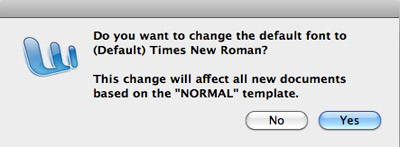

- DEFAULT FONT WORD FOR MAC FOR MAC
- DEFAULT FONT WORD FOR MAC INSTALL
- DEFAULT FONT WORD FOR MAC UPDATE
- DEFAULT FONT WORD FOR MAC UPGRADE
- DEFAULT FONT WORD FOR MAC PRO

When I opened a web page to show her what TNR is supposed to look like and that it clearly wasn't the Font we were both seeing on screen (she still had the remote connection open) she still insisted that this is the version of TNR included by Microsoft. The support person then said 'you have Times New Roman in your program sir, that is the version of TNR we have'. When I opened a Word doc with the TNR font the same thing happened again – in the Font menu it said the document was in TNR, but it clearly didn't look like it on screen, it defaulted to a sans serif font something like Calibri.
DEFAULT FONT WORD FOR MAC FOR MAC
The support person did a remote connection with my Mac and uninstalled Office for Mac 2016 and then did a clean reinstall of it. not being able to read Times New Roman properly on my Mac with Word for Mac 2016. Today I contacted Microsoft Support about may main problem, i.e.
DEFAULT FONT WORD FOR MAC UPDATE
UPDATE for anyone else who has this problem and reads my initial query – Many thanks in advance for any orientation, As part of uninstalling 2011 I had to trash this folder, but Office 2016 doesn't seem to have replaced it with an equivalent version of TNR.ĭOES THIS MEAN that if I do something as simple as move the Times New Roman.ttf out of the Macintosh HD/Library/Fonts Disabled folder and into the Fonts folder next to it this could restore TNR in Office 2016? I didn't want to try it without asking for any suggestions first.Īs to the contradictions between the different Font folders and Font Book any suggestions would be helpful too, but for me this is a less urgent question since the other fonts, wherever they appear, seem to work. I have seen on one site that Office for 2011 disabled certain Apple ttf fonts (including TNR) and replaced them with its own in a Microsoft fonts folder. And in Font Book the lists are different again.Īlso, Times New Roman still shows up on my computer in Font Book, as an active font, and in the Fonts Disabled folder in Macintosh HD/Library (all ttf fonts). For one thing, I'm confused about the different Font folders in my Mac – I have both a Fonts and a Fonts Disabled folder in the main Library (alt-Go from Finder) with two sets of lists of Fonts, and also Fonts and Fonts Disabled folders in the Library reached from Macintosh HD with lists that are different. In searches I've seen that other people have had the same problem with Office for Mac 2016 but none of the solutions given seem to exactly match what I see on my screen so I want to ask again. I had never had a problem with it in Office 2011. I need to use TNR for work purposes so telling me to use another one is not helpful. It still says TNR in the font box at the top of the document, but the font on screen defaults to Calibri or some other sans serif font. Then I saw a message to uninstall 2011, which I did.Įverything seems to work ok EXCEPT that Word documents (I don't know about Excel) no longer recognise Times New Roman fonts. So I downloaded Office 2016, which installed itself alongside the 2011 without overwriting it. There was no advice visible to uninstall Office 2011 first, and in fact I worried about doing so in case the 2016 didn't work properly.
DEFAULT FONT WORD FOR MAC UPGRADE
I also have an Office 365 subscription and recently saw that I could upgrade to Office 2106.
DEFAULT FONT WORD FOR MAC PRO
ttf file, and while the preview window is opened you can use it in most of the programs you'll launch (apart from a few exceptions like OpenOffice).I have a MacBook Pro with Yosemite 10.10.4.
DEFAULT FONT WORD FOR MAC INSTALL
Tip (for Windows XP/Vista, not Windows 7/8): if you occasionally need a font, you don't need to install it. There are some videos on YouTube if that helps. Although this method is laborious, it would seem that it functions better in some cases. in the Fonts folder menu then browse the fonts, instead of drag and drop the fonts into the window. You can also go through: File > Install a new font. You must first drag and drop it anywhere (for example on the desktop) then into the Fonts folder. ttf from the zip window to the Fonts window. Note that with the internal unzip tool of Windows (unlike Winzip), you cannot install a font by a simple drag and drop of the. (can be reached as well by the Start Menu > Control Panel > Appearance and Themes > Fonts). fon) into the Fonts folder, usually C:\ Windows\Fonts or C:\ WINNT\Fonts


 0 kommentar(er)
0 kommentar(er)
